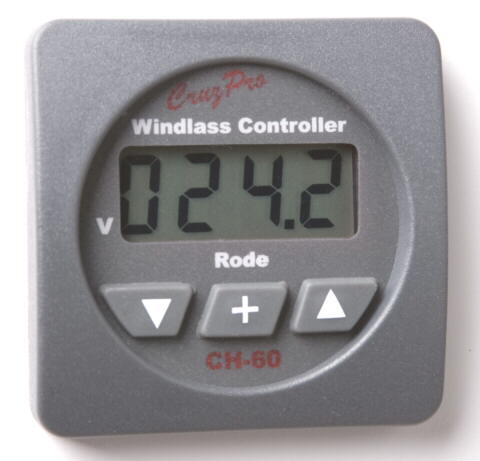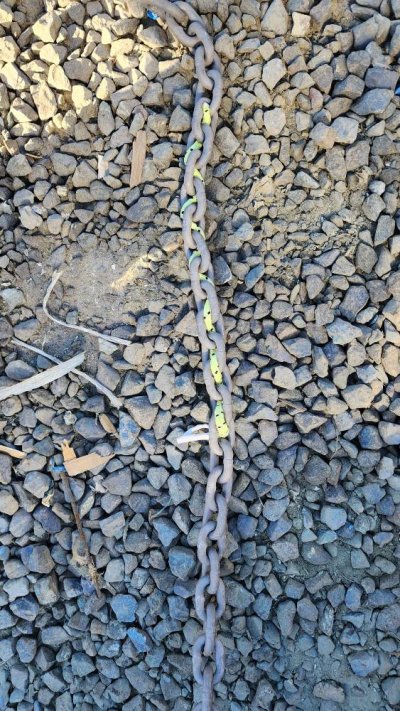SteveK
Guru
- Joined
- Jul 5, 2019
- Messages
- 5,074
- Location
- Gulf Isalnds BC canada
- Vessel Name
- Sea Sanctuary
- Vessel Make
- Bayliner 4588
Peter, How was it to run the wires to the bridge
Mine never failed in the 12 years after I installed it, and how 'simple' is it when you need to up-anchor and move in a hurry say, at night, p*ssing down with rain and wind, and the bottom muck is making the thingies on your rode hard to see, even with a light shone on them. I suspect you'd have to go out in person to deal with it. I could do that all from the comfort and protection of the inside helm, without added light, or having to step out at all. Even with my old tub, I still think it was one of the best things I ever did to her.
Is there anyone out there who used to say all those things OC Diver and others have said on this that has actually finally installed one..? And your experience has been..? Would you ever go back to counting thingies..?
Mine never failed in the 12 years after I installed it, and how 'simple' is it when you need to up-anchor and move in a hurry say, at night, p*ssing down with rain and wind, and the bottom muck is making the thingies on your rode hard to see, even with a light shone on them. I suspect you'd have to go out in person to deal with it. I could do that all from the comfort and protection of the inside helm, without added light, or having to step out at all. Even with my old tub, I still think it was one of the best things I ever did to her.
Is there anyone out there who used to say all those things OC Diver and others have said on this that has actually finally installed one..? And your experience has been..? Would you ever go back to counting thingies..? [emoji3]
Anyone tried these gadgets? Expensive for what they are, but do they work?
https://www.westmarine.com/imtra-corporation-3-8inch-chain-marker-red-17192881.html
Yep, I’ve had a Cruz Pro for 19 years. It has never failed. Would never go back to counting thingies you can’t see in the dark. I know that the chain deploys at 1 meter per second - or near as dammit - so a wrist watch is my back up chain counter - if ever needed.
Yep, you taught me this method, although I used a different color scheme, and my spacing was 20ft. W have 550ft of chain.We painted ours for several reason’s. Bright white first and last 25 feet of our chain. Main anchor was all chain. Then we painted orange every 25 feet for a few feet and at each 100 ft mark added white on both ends.
1) We wanted to be able to see clearly from the pilot house in order to set or retrieve the anchor. I was able to drive up on the chain when retrieving and backing down when setting. We preferred not over working the windless anymore than required during retrieval. The zip ties were hard to see unless we were up on the bow during the process.
2) Painting the chain was required every couple of years and forced us to inspect the entire chain as well as connecting points During this process.
3) Was easier to wash down the chain when required.
Hope that explained our process.
What does the actual counter at the windlass look like? I have very little room between the chainwheel and the anchor shackle because I have maxed out my anchor size. I'm not sure I would have any room to mount one the counter mechanism.
It was easy Steve. Simple as really. The only two things that were a bit of a challenge was the original magnet rusted away over about 2 years, so I just replaced it with a bigger rust-resistant ferrite one. Had to buy about 20 to get one. Still have the other 19 saved away somewhere.Peter, How was it to run the wires to the bridge
And if you're dumping chain using the clutch how does a counter work for you then?
This photo basically shows how it goes with a horizontal windlass arrangement. With a vertical one, you'd need to mount the sensors looking up from below I guess, but the principle is the same.What does the actual counter at the windlass look like? I have very little room between the chainwheel and the anchor shackle because I have maxed out my anchor size. I'm not sure I would have any room to mount one the counter mechanism.
I still find it amazing, after all these years, that when this subject comes up, how few have actually bothered to install an actual chain-counter. There are a number of quite inexpensive ones out there easily installed by ones-self. There are expensive fancy ones too - ones that actually park themselves and are virtually hands-free, but the simple ones are still amazing.
Now Peter, some of us ( maybe most of us) are just old and stubborn. But if we had a chain counter that worked in the first place, I doubt we would have done the Paint/Rope/Zip tie thing….just saying.
I still find it amazing, after all these years, that when this subject comes up, how few have actually bothered to install an actual chain-counter.


For those with CRS
My watch has a stopwatch function. My gypsey spools chain out at 1'/sec.
My coloured
zip ties are arranged according to the rainbow ROYGBIV (red, orange, yellow, green, indigo violet) though not all colours appear.
I had never heard of this. I am installing new chain. I assume this is what you're talking about? 5/16" G4 chain with 1/4" polypropylene line. Sound about right?Best method I found was to buy colored polypropylene 1/4" rope and weave it through the links. I found a supplier who had six different colors and would sell it my the foot. I used 20' lengths, but 5' to 10' would be more realistic. Don't tie the ends to the chain as only the first link or 2 will come out. It goes right through the windlass without issue. Probably have 300 plus deployments with no significant wear.
Ted

I had never heard of this. I am installing new chain. I assume this is what you're talking about? 5/16" G4 chain with 1/4" polypropylene line. Sound about right?
Thanks in advance.
Peter View attachment 134306
Thanks Ted. Good tip on length.Yes, that's what mine looks like. Depending on windlass speed, you might want to make it a little longer. I did 20' originally, but will reduce it to 10' as my windlass goes really fast dropping the anchor.
Ted
I just did my new chain this morning. I went with 50-foot increments. I thought about 25 foot, but the more I thought about it, the more I thought it would be confusing to have too many markings. 50-ft is 7-10 foot water depth difference at 5:1 to 7:1 scope. If I need to lay 125 ft, I'll go 100 feet and then some.Probably time for me to re-do mine, as the paint is wearing after two years. Weaving small stuff sounds good. Seems to me that the best thing would be color coded and night time reflective. For me, 20 foot increments (five colors) would work and then repeat. I keep a little DIY plasticized flip tablet at the helm (so that I can read a MayDay, quickly decipher a horn signal, etc.). Another page to remind me something like red=20 feet, blue=40 feet (and red=120 feet, blue=140 feet) would be simple. Also would be great if the small stuff was reflective for nighttime use (which would require more attention, as does everything at night). All I need is to find a cheap ($5) package 5 different colors of reflective paracord. If I was at home I would have linked to it at Amazon. I've used it before and the reflective ability is impressive.
I had never heard of this. I am installing new chain. I assume this is what you're talking about? 5/16" G4 chain with 1/4" polypropylene line. Sound about right?
Thanks in advance.
Peter View attachment 134306
